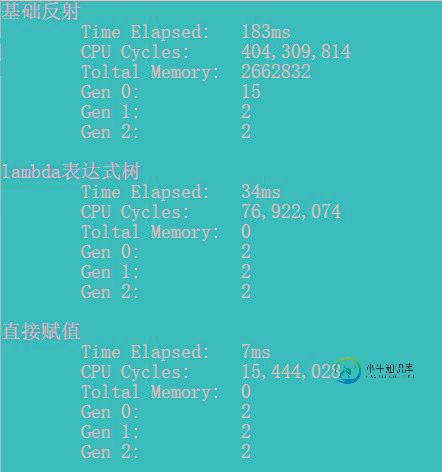利用lambda表达式树优化反射详解
前言
本节重点不讲反射机制,而是讲lambda表达式树来替代反射中常用的获取属性和方法,来达到相同的效果但却比反射高效。
每个人都知道,用反射调用一个方法或者对属性执行SetValue和GetValue操作的时候都会比直接调用慢很多,这其中设计到CLR中内部的处理,不做深究。然而,我们在某些情况下又无法不使用反射,比如:在一个ORM框架中,你要将一个DataRow转化为一个对象,但你又不清楚该对象有什么属性,这时候你就需要写一个通用的泛型方法来处理,以下代码写得有点恶心,但不妨碍理解意思:
//将DataReader转化为一个对象
private static T GetObj<T>(SqliteDataReader reader) where T : class
{
T obj = new T();
PropertyInfo[] pros = obj.GetType().GetProperties();
foreach (PropertyInfo item in pros)
{
try
{
Int32 Index = reader.GetOrdinal(item.Name);
String result = reader.GetString(Index);
if (typeof(String) == item.PropertyType)
{
item.SetValue(obj, result);
continue;
}
if (typeof(DateTime) == item.PropertyType)
{
item.SetValue(obj, Convert.ToDateTime(result));
continue;
}
if (typeof(Boolean) == item.PropertyType)
{
item.SetValue(obj, Convert.ToBoolean(result));
continue;
}
if (typeof(Int32) == item.PropertyType)
{
item.SetValue(obj, Convert.ToInt32(result));
continue;
}
if (typeof(Single) == item.PropertyType)
{
item.SetValue(obj, Convert.ToSingle(result));
continue;
}
if (typeof(Single) == item.PropertyType)
{
item.SetValue(obj, Convert.ToSingle(result));
continue;
}
if (typeof(Double) == item.PropertyType)
{
item.SetValue(obj, Convert.ToDouble(result));
continue;
}
if (typeof(Decimal) == item.PropertyType)
{
item.SetValue(obj, Convert.ToDecimal(result));
continue;
}
if (typeof(Byte) == item.PropertyType)
{
item.SetValue(obj, Convert.ToByte(result));
continue;
}
}
catch (ArgumentOutOfRangeException ex)
{
continue;
}
}
return obj;
}
对于这种情况,其执行效率是特别低下的,具体多慢在下面例子会在.Net Core平台上和.Net Framework4.0运行测试案例.对于以上我举例的情况,效率上我们还可以得到提升。但对于想在运行时修改一下属性的名称或其他操作,反射还是一项特别的神器,因此在某些情况下反射还是无法避免的。
但是对于只是简单的SetValue或者GetValue,包括用反射构造函数,我们可以想一个中继的方法,那就是使用表达式树。对于不理解表达式树的,可以到微软文档查看,点击我。表达式树很容易通过对象模型表示表达式,因此强烈建议学习。查看以下代码:
static void Main()
{
Dog dog = new Dog();
PropertyInfo propertyInfo = dog.GetType().GetProperty(nameof(dog.Name)); //获取对象Dog的属性
MethodInfo SetterMethodInfo = propertyInfo.GetSetMethod(); //获取属性Name的set方法
ParameterExpression param = Expression.Parameter(typeof(Dog), "param");
Expression GetPropertyValueExp = Expression.Lambda(Expression.Property(param, nameof(dog.Name)), param);
Expression<Func<Dog, String>> GetPropertyValueLambda = (Expression<Func<Dog, String>>)GetPropertyValueExp;
ParameterExpression paramo = Expression.Parameter(typeof(Dog), "param");
ParameterExpression parami = Expression.Parameter(typeof(String), "newvalue");
MethodCallExpression MethodCallSetterOfProperty = Expression.Call(paramo, SetterMethodInfo, parami);
Expression SetPropertyValueExp = Expression.Lambda(MethodCallSetterOfProperty, paramo, parami);
Expression<Action<Dog, String>> SetPropertyValueLambda = (Expression<Action<Dog, String>>)SetPropertyValueExp;
//创建了属性Name的Get方法表达式和Set方法表达式,当然只是最简单的
Func<Dog, String> Getter = GetPropertyValueLambda.Compile();
Action<Dog, String> Setter = SetPropertyValueLambda.Compile();
Setter?.Invoke(dog, "WLJ"); //我们现在对dog这个对象的Name属性赋值
String dogName = Getter?.Invoke(dog); //获取属性Name的值
Console.WriteLine(dogName);
Console.ReadKey();
}
public class Dog
{
public String Name { get; set; }
}
以下代码可能很难看得懂,但只要知道我们创建了属性的Get、Set这两个方法就行,其结果最后也能输出狗的名字 WLJ,拥有ExpressionTree的好处是他有一个名为Compile()的方法,它创建一个代表表达式的代码块。现在是最有趣的部分,假设你在编译时不知道类型(在这篇文章中包含的代码我在不同的程序集上创建了一个类型)你仍然可以应用这种技术,我将对于常用的属性的set,get操作进行分装。
/// <summary>
/// 属性类,仿造反射中的PropertyInfo
/// </summary>
public class Property
{
private readonly PropertyGetter getter;
private readonly PropertySetter setter;
public String Name { get; private set; }
public PropertyInfo Info { get; private set; }
public Property(PropertyInfo propertyInfo)
{
if (propertyInfo == null)
throw new NullReferenceException("属性不能为空");
this.Name = propertyInfo.Name;
this.Info = propertyInfo;
if (this.Info.CanRead)
{
this.getter = new PropertyGetter(propertyInfo);
}
if (this.Info.CanWrite)
{
this.setter = new PropertySetter(propertyInfo);
}
}
/// <summary>
/// 获取对象的值
/// </summary>
/// <param name="instance"></param>
/// <returns></returns>
public Object GetValue(Object instance)
{
return getter?.Invoke(instance);
}
/// <summary>
/// 赋值操作
/// </summary>
/// <param name="instance"></param>
/// <param name="value"></param>
public void SetValue(Object instance, Object value)
{
this.setter?.Invoke(instance, value);
}
private static readonly ConcurrentDictionary<Type, Core.Reflection.Property[]> securityCache = new ConcurrentDictionary<Type, Property[]>();
public static Core.Reflection.Property[] GetProperties(Type type)
{
return securityCache.GetOrAdd(type, t => t.GetProperties().Select(p => new Property(p)).ToArray());
}
}
/// <summary>
/// 属性Get操作类
/// </summary>
public class PropertyGetter
{
private readonly Func<Object, Object> funcGet;
public PropertyGetter(PropertyInfo propertyInfo) : this(propertyInfo?.DeclaringType, propertyInfo.Name)
{
}
public PropertyGetter(Type declareType, String propertyName)
{
if (declareType == null)
{
throw new ArgumentNullException(nameof(declareType));
}
if (propertyName == null)
{
throw new ArgumentNullException(nameof(propertyName));
}
this.funcGet = CreateGetValueDeleagte(declareType, propertyName);
}
//代码核心部分
private static Func<Object, Object> CreateGetValueDeleagte(Type declareType, String propertyName)
{
// (object instance) => (object)((declaringType)instance).propertyName
var param_instance = Expression.Parameter(typeof(Object));
var body_objToType = Expression.Convert(param_instance, declareType);
var body_getTypeProperty = Expression.Property(body_objToType, propertyName);
var body_return = Expression.Convert(body_getTypeProperty, typeof(Object));
return Expression.Lambda<Func<Object, Object>>(body_return, param_instance).Compile();
}
public Object Invoke(Object instance)
{
return this.funcGet?.Invoke(instance);
}
}
public class PropertySetter
{
private readonly Action<Object, Object> setFunc;
public PropertySetter(PropertyInfo property)
{
if (property == null)
{
throw new ArgumentNullException(nameof(property));
}
this.setFunc = CreateSetValueDelagate(property);
}
private static Action<Object, Object> CreateSetValueDelagate(PropertyInfo property)
{
// (object instance, object value) =>
// ((instanceType)instance).Set_XXX((propertyType)value)
//声明方法需要的参数
var param_instance = Expression.Parameter(typeof(Object));
var param_value = Expression.Parameter(typeof(Object));
var body_instance = Expression.Convert(param_instance, property.DeclaringType);
var body_value = Expression.Convert(param_value, property.PropertyType);
var body_call = Expression.Call(body_instance, property.GetSetMethod(), body_value);
return Expression.Lambda<Action<Object, Object>>(body_call, param_instance, param_value).Compile();
}
public void Invoke(Object instance, Object value)
{
this.setFunc?.Invoke(instance, value);
}
}
在将代码应用到实例:
Dog dog = new Dog(); PropertyInfo propertyInfo = dog.GetType().GetProperty(nameof(dog.Name)); //反射操作 propertyInfo.SetValue(dog, "WLJ"); String result = propertyInfo.GetValue(dog) as String; Console.WriteLine(result); //表达式树的操作 Property property = new Property(propertyInfo); property.SetValue(dog, "WLJ2"); String result2 = propertyInfo.GetValue(dog) as String; Console.WriteLine(result2);
发现其实现的目的与反射一致,但效率却有明显的提高。
以下测试以下他们两之间的效率。测试代码如下:
Student student = new Student();
PropertyInfo propertyInfo = student.GetType().GetProperty(nameof(student.Name));
Property ExpProperty = new Property(propertyInfo);
Int32 loopCount = 1000000;
CodeTimer.Initialize(); //测试环境初始化
//下面该方法个执行1000000次
CodeTimer.Time("基础反射", loopCount, () => {
propertyInfo.SetValue(student, "Fode",null);
});
CodeTimer.Time("lambda表达式树", loopCount, () => {
ExpProperty.SetValue(student, "Fode");
});
CodeTimer.Time("直接赋值", loopCount, () => {
student.Name = "Fode";
});
Console.ReadKey();
其.Net4.0环境下运行结果如下:

.Net Core环境下运行结果:

从以上结果可以知道,迭代同样的次数反射需要183ms,而用表达式只要34ms,直接赋值需要7ms,在效率上,使用表达式这种方法有显著的提高,您可以看到使用此技术可以完全避免使用反射时的性能损失。反射之所以效率有点低主要取决于其加载的时候时在运行期下,而表达式则在编译期,下篇有空将会介绍用Emit技术优化反射,会比表达式略快一点。
注:对于常用对象的属性,最好将其缓存起来,这样效率会更高。。
代码下载
总结
以上就是这篇文章的全部内容了,希望本文的内容对大家的学习或者工作具有一定的参考学习价值,如果有疑问大家可以留言交流,谢谢大家对小牛知识库的支持。
-
本文向大家介绍python中Lambda表达式详解,包括了python中Lambda表达式详解的使用技巧和注意事项,需要的朋友参考一下 如果你在学校读的是计算机科学专业,那么可能学过 Lambda 表达式, 不过可能从来没有用过它。如果你不是计算机科学专业,它们看着可能 有点儿陌生(或者只是“曾经学习过的东西”)。在这一节里,虽然我们 不打算深入学习这类函数,但是会用几个例子来演示它们是如何用在网
-
本文向大家介绍基于C++ Lambda表达式的程序优化,包括了基于C++ Lambda表达式的程序优化的使用技巧和注意事项,需要的朋友参考一下 什么是Lambda? C++ 11加入了一个非常重要的特性——Lambda表达式。营里(戴维营)的兄弟都对Objective-C很熟悉,许多人多block情有独钟,将各种回调函数、代理通通都用它来实现。甚至有人选择用FBKVOController、Bloc
-
我有一个与Java8中的lambda表达式有关的问题。 下面是我的代码: 使用此代码,我只能得到一个条目。你能帮我弄一个通过筛选的所有条目的列表吗?
-
(译注:目前支持lambda的gcc编译器版本为4.5,其它详细的编译器对于C++11新特性的支持请参考http://wiki.apache.org/stdcxx/C%2B%2B0xCompilerSupport) Lambda表达式是一种描述函数对象的机制,它的主要应用是描述某些具有简单行为的函数(译注:Lambda表达式也可以称为匿名函数,具有复杂行为的函数可以采用命名函数对象,当然,何谓复杂
-
本文向大家介绍Java8 Lambda表达式详解及实例,包括了Java8 Lambda表达式详解及实例的使用技巧和注意事项,需要的朋友参考一下 第一个Lambda表达式 在Lambda出现之前,如果我们需要写一个多线程可能需要下面这种方式: 上面的例子如果改成使用Lambda就会简单许多: Lambda表达式是一个匿名函数,将行为像数据一样传递,表达式使用 -> 将参数和主体分开, -> 前面是参
-
Lambda表达式在Java 8中引入,并被吹捧为Java 8的最大特性.Lambda表达式有助于函数式编程,并简化了很多开发。 语法 (Syntax) lambda表达式的特征在于以下语法。 parameter -> expression body 以下是lambda表达式的重要特征。 Optional type declaration - 无需声明参数类型。 编译器可以从参数的值推断出相同的

